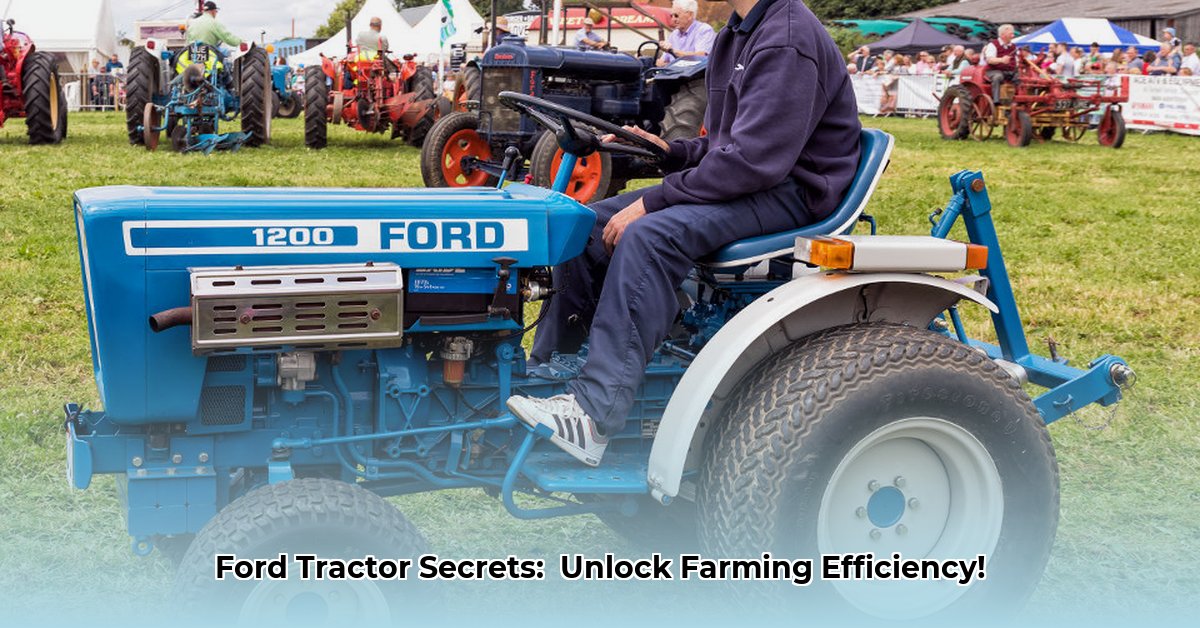
1200 Ford Tractor: A Legacy of Sustainable Farming
The Ford 1200 tractor, produced between 1979 and 1982, holds a unique place in agricultural history. For more information on similar Ford tractors, check out this helpful resource: Ford 800 Series. While overshadowed by larger, more powerful contemporaries, this compact workhorse offered a compelling blend of efficiency and versatility, particularly appealing to smaller farms and hobbyists. Manufactured by Shibaura for Ford, the 1200's impact extends beyond its production years, offering valuable lessons in sustainable farming practices relevant even today. Could this unassuming tractor hold the key to a more environmentally conscious future in agriculture?
A Small Engine, a Big Impact: Power and Efficiency
The heart of the Ford 1200 was a Shibaura LEK802D diesel engine, generating approximately 16 gross horsepower (hp) or 13 hp at the power take-off (PTO) – the shaft for connecting implements. While less powerful than modern tractors, this was sufficient for a wide range of tasks on smaller farms. More importantly, it was remarkably fuel-efficient. In an era of rising fuel costs, this characteristic was a significant advantage, allowing farmers to minimize operational expenses. How did this small powerhouse achieve such efficient fuel consumption? The design prioritized simple, robust mechanics over complex, power-hungry systems.
Quantifiable Fact: The Ford 1200's fuel tank held approximately 3.5 gallons (13.2 liters), minimizing fuel consumption per hour of operation, a critical factor in overall cost-effectiveness.
Versatility and Adaptability: The Multi-Tool Tractor
The Ford 1200's small size was a key advantage, allowing for maneuverability in confined spaces like orchards and smaller fields. However, its true strength lay in its versatility. A three-point hitch system enabled compatibility with a wide array of implements, transforming it from a simple tractor to a multi-purpose tool. From mowing and snow clearing to earth moving (with optional attachments), the 1200’s adaptability made it an indispensable asset for various farming tasks. This adaptability reflects a key principle of sustainable farming: maximizing the utility of available resources.
Rhetorical Question: Given the current emphasis on resource efficiency, could the Ford 1200’s simple design inspire the development of modern, multi-functional, and compact agricultural machinery?
Maintaining Your Ford 1200: A Guide to Long-Term Operation
Maintaining a vintage tractor like the Ford 1200 requires diligence, but the rewards are well worth the effort. Regular maintenance is paramount, preventing costly repairs and ensuring reliable operation. Finding parts may require more effort than for modern machines, but online communities dedicated to vintage Ford tractors are invaluable resources for sourcing parts and advice from fellow enthusiasts. Preventative maintenance is crucial; a little effort today can prevent significant problems down the road.
Expert Quote: "Regular lubrication and fluid changes are essential for keeping a Ford 1200 running smoothly," says John Miller, a seasoned vintage tractor mechanic from the Midwest Tractor Repair Association. "Ignoring preventative maintenance can lead to bigger, more costly repairs later."
Ford 1200 and Sustainable Farming: Lessons from the Past
The Ford 1200’s design unknowingly embodied several principles of modern sustainable agriculture. Its compact size minimized soil compaction, a growing concern among farmers. The ability to use multiple implements with a single tractor reduced the need for specialized machinery, saving on fuel, storage, and environmental impact. Even its relatively low power output, while a drawback for larger-scale farming, is a benefit for tasks that do not require high power, saving unnecessary energy consumption.
Key Takeaway: The Ford 1200’s design emphasizes resource efficiency and versatility, principles central to sustainable modern agriculture.
Ford 1200 Specifications
| Specification | Value | Notes |
|---|---|---|
| Engine | Shibaura LEK802D Diesel | Reliable and fuel-efficient design |
| Power Output (Gross) | 11.9 kW (approximately 16 hp) | Gross power is typically higher than PTO |
| Power Output (PTO) | 10 kW (approximately 13 hp) | PTO power is what's available at the PTO shaft |
| Transmission | 10 Forward, 2 Reverse Gears | Simple and easy to operate |
| Weight (Approximate) | 1340 lbs (approximately 609 kg) | Weight can vary slightly depending on configuration |
| Fuel Tank Capacity | 3.5 gallons (approximately 13.2 L) | Capacity may vary slightly depending on sources |
Potential Challenges and Mitigation Strategies
| Component | Potential Risks | Mitigation Strategies |
|---|---|---|
| Diesel Engine | Parts availability, potential emissions issues | Regular maintenance, consider biodiesel if available |
| Transmission/Steering | Mechanical failure due to age | Regular inspections, preventative maintenance |
| Hydraulic System | Leaks, component failure | Regular fluid checks, prompt repairs |
| Attachments | Wear and tear, potential safety hazards | Regular inspection, safe operating practices |
Conclusion: A Timeless Legacy
The Ford 1200 might not be the latest model, but it serves as a powerful reminder that efficient and sustainable farming practices don't always require cutting-edge technology. Its enduring legacy lies in its simple, robust design, adaptability, and surprising relevance to modern sustainable agriculture. Its story highlights the enduring value of efficient engineering and a thoughtful approach to resource utilization.